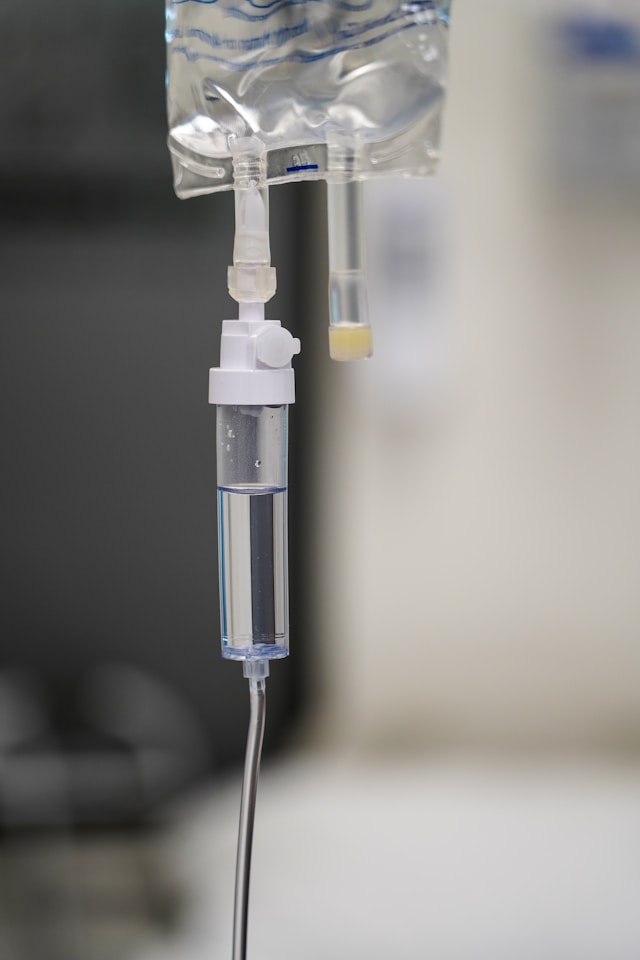
Infusion Therapy for Psoriatic Arthritis


Dr. Chen is a board-certified immunologist with over 15 years of experience treating autoimmune and immunodeficiency disorders. She specializes in IVIG therapy and has published extensively on immune system treatments.
Medical Disclaimer
Psoriatic arthritis (PsA) is a chronic inflammatory condition that affects both your joints and skin, combining the joint pain and swelling of arthritis with the scaly skin patches of psoriasis. For many people living with PsA, infusion therapy offers powerful relief when oral medications aren't enough to control symptoms. Biologic infusions can reduce joint inflammation, improve skin symptoms, and help prevent the progressive joint damage that PsA can cause. Understanding how infusion therapy treats psoriatic arthritis helps you make informed decisions about managing this complex condition.
Key Highlights
- Biologic infusion therapies for PsA work by targeting specific inflammatory proteins like TNF-alpha and interleukins that drive both joint and skin symptoms.
- Common infusion medications include Remicade, Simponi Aria, Orencia, and Stelara (initial dose), typically given every 4-12 weeks depending on the medication.
- Many PsA patients experience improvement in both joint symptoms and skin psoriasis within weeks of starting infusion therapy, with continued improvement over several months.
Understanding Psoriatic Arthritis
Psoriatic arthritis is an autoimmune disease where your immune system attacks your own joints and skin, causing inflammation. About 30% of people with psoriasis (a skin condition causing red, scaly patches) develop psoriatic arthritis, though joint symptoms can occasionally appear before skin symptoms.
PsA doesn't affect everyone the same way. Some people experience mild joint pain and skin symptoms, while others face severe, disabling disease. Common patterns include symmetric arthritis (affecting joints on both sides of the body), asymmetric arthritis (affecting just a few joints on one side), distal arthritis (affecting finger and toe joints near nails), spondylitis (spine inflammation), and arthritis mutilans (a severe, deforming type).
Beyond joints and skin, PsA can cause enthesitis (inflammation where tendons attach to bone), dactylitis (entire finger or toe swelling), nail changes, eye inflammation, and fatigue. According to the National Psoriasis Foundation, approximately 1.5 million Americans have psoriatic arthritis, with most developing it between ages 30-50.
Left untreated, PsA can cause permanent joint damage, reduced function, and disability. Early aggressive treatment helps prevent these complications.
Why Infusion Therapy for Psoriatic Arthritis
Infusion therapy becomes appropriate for PsA in several scenarios:
Inadequate Response to Conventional Treatments: When NSAIDs, oral DMARDs like methotrexate, or topical psoriasis treatments don't adequately control joint or skin symptoms, biologic infusions offer more targeted disease modification.
Moderate to Severe Disease: Patients with multiple swollen joints, significant skin involvement, enthesitis, or elevated inflammatory markers often need the stronger immunosuppression that biologics provide.
Preventing Joint Damage: Biologics can slow or stop the progressive joint erosion and deformity that PsA causes. The American College of Rheumatology recommends biologic therapy for PsA patients with active disease despite conventional treatment.
Treating Multiple Symptoms: Biologic infusions can simultaneously address joint inflammation, skin psoriasis, and other PsA manifestations with a single medication, simplifying treatment.
Improving Quality of Life: PsA significantly impacts daily function, work ability, and emotional wellbeing. Biologics can provide relief that transforms quality of life.
Common Infusion Medications for Psoriatic Arthritis
Several biologic infusions are FDA-approved for treating PsA:
Remicade (Infliximab): A TNF-alpha inhibitor that blocks a key inflammatory protein driving both joint and skin inflammation. Given every 8 weeks after loading doses at weeks 0, 2, and 6. Remicade has extensive long-term data and treats both arthritis and psoriasis effectively. Infusions typically take 2-3 hours initially, potentially shortened with established tolerance.
Simponi Aria (Golimumab IV): Another TNF inhibitor given every 8 weeks (after initial and 4-week doses). With 30-minute infusion times, it's one of the quickest biologic options. Simponi Aria improves joint symptoms and can also benefit skin psoriasis.
Orencia (Abatacept): Works by blocking T-cell activation, preventing immune cells from triggering inflammation. Given every 4 weeks with 30-60 minute infusions. While primarily used for joint symptoms, some patients notice skin improvement too.
Stelara (Ustekinumab): An IL-12/23 inhibitor that blocks interleukins involved in PsA inflammation. The first dose is given by infusion (taking about 1 hour), then patients transition to self-injections every 12 weeks at home. Stelara is particularly effective for both joint and skin symptoms.
Inflectra and Renflexis: Biosimilar versions of Remicade that work identically but may cost less. Given on the same schedule as Remicade.
According to the Mayo Clinic, biologic therapies have significantly improved outcomes for psoriatic arthritis patients, with many achieving minimal disease activity.
What to Expect from Infusion Therapy
Pre-Treatment Screening: Before starting biologic therapy, you'll need screening tests including tuberculosis testing, hepatitis panel, complete blood count, liver function tests, and sometimes chest X-ray. These ensure it's safe to begin immunosuppressive treatment.
Loading Dose Schedules: Some medications require more frequent initial infusions to achieve therapeutic levels quickly, then space out to maintenance intervals.
Timeline for Improvement: Most PsA patients notice improvement in joint pain and stiffness within 2-8 weeks of starting infusion therapy. Skin psoriasis may take slightly longer to improve, often showing significant clearing by 12-16 weeks. Full benefit typically develops over 3-6 months.
Combination Therapy: You may continue oral medications like methotrexate alongside your infusion biologic, especially initially. Some patients eventually discontinue oral DMARDs once biologic therapy achieves disease control.
Ongoing Monitoring: Regular rheumatology appointments, physical exams, lab work (checking blood counts, liver function, inflammation markers), and symptom tracking help assess treatment effectiveness and safety.
Benefits of Infusion Therapy for PsA
Patients responding well to biologic infusions often experience:
Reduced Joint Pain and Swelling: Significant decrease in tender, swollen joints and improved range of motion.
Decreased Morning Stiffness: Less severe stiffness upon waking and throughout the day.
Improved Skin Symptoms: Reduction in psoriasis plaques, less scaling and redness, and clearer skin. Some patients achieve complete or near-complete skin clearing.
Enthesitis Relief: Decreased pain at tendon attachment points (common areas include Achilles tendons, elbows, and plantar fascia).
Reduced Dactylitis: Improvement in "sausage digits" (swollen fingers or toes).
Nail Improvement: Psoriatic nail changes like pitting, thickening, or separation may improve with treatment.
Prevention of Joint Damage: Slowing or stopping progressive joint destruction visible on imaging studies.
Better Physical Function: Improved ability to perform daily activities, work tasks, and participate in exercise or hobbies.
Reduced Fatigue: Many patients report significant energy improvement.
Enhanced Quality of Life: Overall improvement in wellbeing, self-esteem (particularly related to skin clearing), and ability to engage in life activities.
The National Institute of Arthritis and Musculoskeletal and Skin Diseases reports that early aggressive treatment with biologics provides the best long-term outcomes for PsA patients.
Potential Side Effects and Risks
Understanding potential risks helps you make informed treatment decisions:
Increased Infection Risk: Biologics suppress immune function, making you more susceptible to infections. Upper respiratory infections, urinary tract infections, and skin infections occur more frequently. Serious infections requiring hospitalization affect a small percentage of patients.
Infusion Reactions: Mild reactions like headache, flushing, or itching can occur during or after infusion. Pre-medications and slower infusion rates usually prevent or minimize these. Severe allergic reactions are rare.
Tuberculosis Risk: Latent TB can reactivate with biologic therapy, which is why screening is required before starting treatment. If latent TB is detected, you'll receive preventive antibiotics first.
Liver Enzyme Changes: Some patients develop elevated liver enzymes, particularly when combining biologics with methotrexate. Regular monitoring detects this early.
Injection Site Reactions: For medications transitioning to self-injection (like Stelara after the initial infusion), redness or soreness at injection sites can occur.
Paradoxical Psoriasis: Rarely, TNF inhibitors can cause new or worsening psoriasis in some patients, though this is uncommon.
Long-Term Considerations: Small increased risk of certain cancers with prolonged biologic use has been suggested in some studies, though data is complex and absolute risk remains low.
Your healthcare team monitors for these issues through regular appointments, symptom assessment, and laboratory testing.
Monitoring and Follow-Up Care
Successful PsA treatment requires ongoing monitoring:
Regular Rheumatology Visits: Typically every 3-4 months initially, potentially spacing out to every 6 months once disease is well-controlled.
Laboratory Monitoring: Periodic blood tests checking complete blood counts, liver function, kidney function, and inflammatory markers.
Skin Assessment: Dermatology follow-up if skin psoriasis remains active or if you develop new skin concerns.
Imaging Studies: X-rays, ultrasound, or MRI if needed to assess joint damage or disease progression.
Treatment Response Evaluation: Your rheumatologist will track joint counts, disease activity scores, and patient-reported outcomes to ensure treatment is working effectively.
Living with PsA on Infusion Therapy
Infection Prevention: Practice careful hand hygiene, avoid sick contacts when possible, stay current on vaccinations (avoiding live vaccines while on biologics), and report fevers or concerning symptoms promptly.
Medication Adherence: Keep infusion appointments consistently. Missing or delaying treatments can lead to disease flare-ups.
Healthy Lifestyle: Regular exercise (adapted to your joint capabilities), maintaining healthy weight, stress management, and adequate sleep all support better disease control and overall health.
Skin Care: Continue appropriate skin care routines for psoriasis even as it improves with treatment. Sun protection remains important.
Joint Protection: Learn proper body mechanics and joint protection techniques from occupational or physical therapists to minimize stress on affected joints.
Cost and Insurance Coverage
Biologic infusions are expensive, but financial assistance makes them accessible:
Insurance Authorization: Most plans cover FDA-approved biologics for PsA with prior authorization. Your rheumatologist's office handles this process.
Copay Assistance: Manufacturer copay cards can reduce out-of-pocket costs to minimal amounts (often $0-50 per infusion) for insured patients.
Patient Assistance Programs: For uninsured or underinsured patients, manufacturers offer free or discounted medication for those meeting income criteria.
Foundation Grants: The National Psoriasis Foundation and independent charitable foundations provide financial assistance for eligible patients.
Frequently Asked Questions
How effective is infusion therapy for psoriatic arthritis?
Infusion biologic therapies are highly effective for most PsA patients. Clinical trials show that 50-70% of patients achieve significant improvement (ACR20 response or better), with 20-40% reaching minimal disease activity. Many patients experience dramatic relief in both joint symptoms and skin psoriasis. Response rates vary by medication and individual factors, but biologics represent one of the most effective treatment approaches for moderate to severe PsA.
Will infusion therapy clear my psoriasis skin symptoms too?
Yes, most biologic infusions used for PsA also treat skin psoriasis effectively. TNF inhibitors like Remicade typically lead to 50-75% skin improvement for many patients, with some achieving complete or near-complete clearing. Stelara (IL-12/23 inhibitor) is particularly effective for skin symptoms. The degree of skin improvement varies by medication and individual response, but significant skin clearing is common. Some patients may still need topical treatments for residual patches.
How long does it take for infusion therapy to work for PsA?
Most PsA patients notice joint symptom improvement within 2-8 weeks of starting infusion therapy, with pain and stiffness decreasing first. Skin psoriasis often takes slightly longer to improve, typically showing significant clearing by 12-16 weeks. Maximum benefit usually develops over 3-6 months. Some patients experience rapid dramatic relief, while others improve more gradually. Maintaining consistent treatment is key to achieving and sustaining improvement.
Can you stop infusion therapy once PsA is controlled?
Stopping biologic therapy typically leads to disease flare-ups within weeks to months, as PsA is a chronic condition that returns when treatment is withdrawn. Most patients need ongoing maintenance therapy to sustain disease control. However, some patients who achieve prolonged remission may be able to extend intervals between infusions or, in rare cases, discontinue treatment under close medical supervision. Any changes to your treatment plan should be discussed thoroughly with your rheumatologist.
What if one infusion medication doesn't work for my PsA?
If your first biologic doesn't provide adequate relief, multiple alternatives exist. Your rheumatologist may switch you to a different medication with a different mechanism of action (for example, from a TNF inhibitor to an IL-17 or IL-12/23 inhibitor). Many PsA patients try more than one biologic before finding optimal treatment. Not responding to one biologic doesn't mean others won't work—individual response varies significantly, and most patients eventually find effective treatment.
Taking Control of Your PsA
Being prescribed infusion therapy for psoriatic arthritis represents an opportunity for significantly better disease control and quality of life. While adjusting to regular infusion appointments takes time, most PsA patients find the symptom relief—both joint and skin improvement—well worth the commitment.
Modern biologic therapies have transformed PsA from a potentially debilitating condition to a manageable disease that allows most patients to maintain active, fulfilling lives with minimal disability.
Ready to explore infusion therapy options for your psoriatic arthritis? Find specialized infusion centers near you that understand PsA and can support your journey toward better disease control.
Medical Disclaimer: This content is for educational purposes only and is not a substitute for professional medical advice, diagnosis, or treatment. Always consult your healthcare provider with questions about your medical condition or treatment options.
Article Statistics


Table of Contents
Article Statistics










